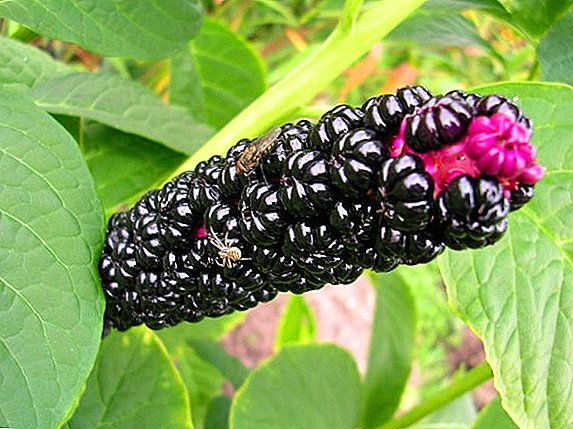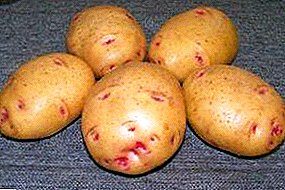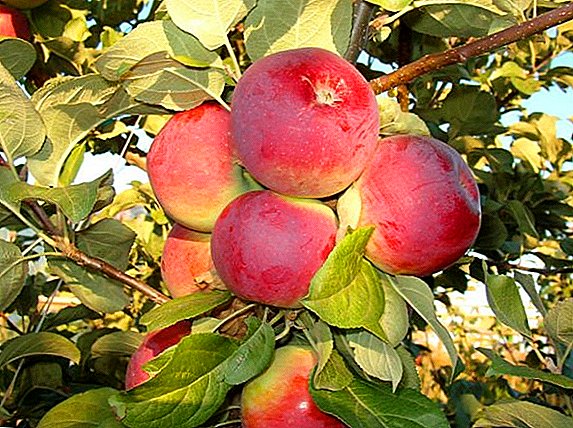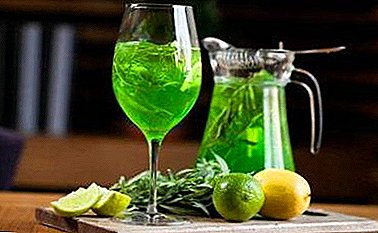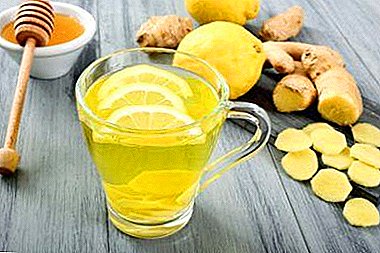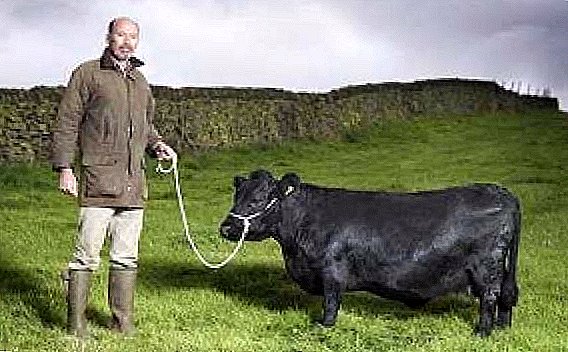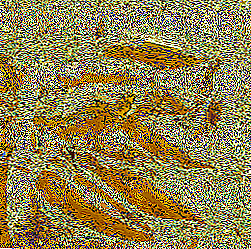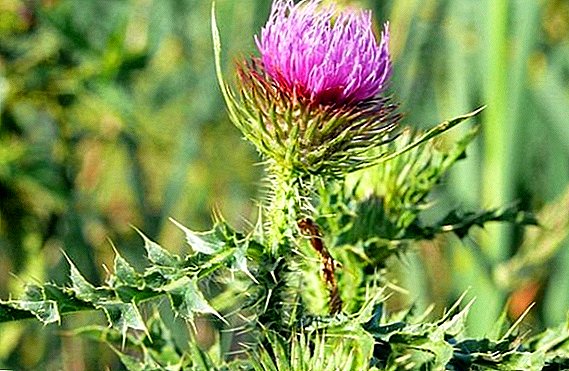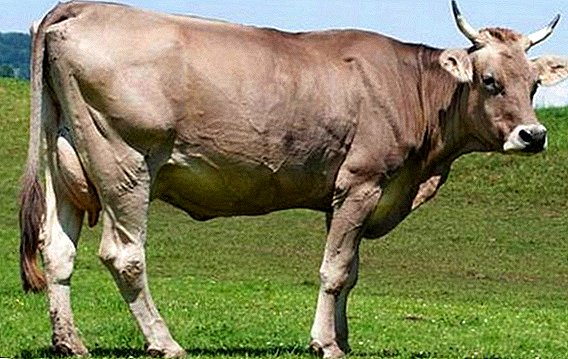 The calm temperament, endurance and satisfactory productivity of Swiss cows attract many farmers.
The calm temperament, endurance and satisfactory productivity of Swiss cows attract many farmers.
But the main feature of this livestock is in intrabreed meat and dairy types.
How to recognize the purebred individuals, what they are in the care and maintenance, what the milk yield is characterized - this will be discussed further in the article.
Breed history and description
Schwyz breed formed over the centuries. Moreover, initially the breeders focused on simplifying the conditions for feeding and feeding the livestock, and later attention was paid to its productive qualities. 
Origin
The roots of purebred cows come from short-lived cattle, which was used in agricultural Europe as a trailing force for agricultural work. Then the breeding work was carried out by natural selection.
Did you know? On the nose, each cow has a unique pattern, like a human fingerprint. In the United States of America, this feature of cattle is used to search for it in case of loss.
A few centuries ago, Swiss breeders set a goal to bring a new generation of cattle, which would be distinguished by unpretentiousness, ease of maintenance, quick adaptation to new conditions and climatic changes.
A little later, when there was no need to attract cows to plow the land, the meat-and-milk direction of the breed's productivity turned out to be in the center of the breeding work. Soon the farmers of neighboring Germany, Italy and France began to be interested in the variety. And by the end of the twentieth century, about Schwyz cows were learned in America.
Yakut mini-cow and Krasnogorbatov also belong to meat and dairy breeds of cows.
External characteristics
Modern livestock breeders have the opportunity to choose the intrabreed type of their ward.  Today there are 3 of them:
Today there are 3 of them:
- lactic;
- milk and meat;
- meat and dairy.
Did you know? The taste of cow's milk directly depends on the feed that feeds the animal. If the product is bitter, most likely, the cow ate wormwood or other bitter grass.
It is characteristic that representatives of each species of the Schwyz breed are distinguished by individual external features.
At the same time, all purebred cows combine the following characteristics:
- powerful backbone;
- right physique;
- height at withers - 129-152 cm;
- short coat;
- brown color (light and dark shading colors are acceptable);
- strong thick legs of medium length;
- powerful, stable hooves;
- massive volume torso;
- short, neck with well-developed muscles;
- wide sacrum;
- elastic skin;
- dark lead hair coat around the nasal area;
- bulging forehead;
- massive horns;
- short head;
- female weight - 550-800 kg, male - 700-1000 kg, newborn calves - 39 kg;
- large udder, which, depending on the intra-breed type of animal, is distinguished by its development.
 Cows meat and dairy directions are easily recognizable by a small body and a weak udder, but the milk and meat representatives have a very elongated body with moderately developed muscle mass.
Cows meat and dairy directions are easily recognizable by a small body and a weak udder, but the milk and meat representatives have a very elongated body with moderately developed muscle mass.Did you know? During the bullfight, the red canvas is used exclusively to attract the viewer's eye, because the bulls, like the cows, do not distinguish colors. They are enraged by the fact of the flickering of an incomprehensible object in front of their nose..
Animals have excellent health, quickly adapt to new conditions, however, they are demanding to the daily diet.
Meat and Dairy Indicators
Throughout its history, the Schwyz breed has constantly improved its outward signs of purebredness, as well as the characteristics of productivity.
However, when comparing these cows with other varieties, Austrian and German farmers note their modest milk yield and size, but Italian and French breeders continue to work on increasing meat and dairy indicators.
Nowadays, the dairy product obtained from these bolenok abroad is used exclusively in the cheese industry.
The beef breeds of cows include hereford, highland, kazakh white-headed and limousine cows, and dairy breeds are black-and-white, Ayrshire, brown Latvian.
Here are the main indicators of productivity from one cow:
- annual milk yield - 9-10 tons;
- fat content of dairy product - 3.6-4.0%;
- the amount of constituent protein is 3.2–3.6%;
- average daily weight gain - 800-1000 g;
- slaughter meat yield - 50-60%;
- meat quality is high.

Advantages and disadvantages
Despite such a long breeding work, Swiss cows are imperfect. In comparison with their purebred relatives of other breeds, they largely lose. Consider specific facts.
| Analysis of the breed of Swiss cows | |
| Virtues | disadvantages |
|
|
Important! Observance of optimal conditions for keeping cattle is a prerequisite for intensive growth of livestock. By the age of one year old chicks of this breed should weigh at least 250 kg, and by the age of 18 months - from 350 to 370 kg.
Maintenance and care
Schwyck cows can be grown stall-pasture or year-round stall methods. The choice depends on the stock of grain crops and the possibilities of harvesting forage grasses. Consequently, the owner needs to take care of proper arrangement of the barn and look after the corresponding summer terrace. 
Summer playground
Many livestock breeders use this method of summer keeping of cattle, which allows you to significantly reduce the cost of dairy products and reduce labor costs. According to veterinarians, the constant stay of the animal in the fresh air among the abundance of herbs has a beneficial effect on its health.
However, to do this, you need to choose the right walking platform. Experienced farmers are advised to avoid low-lying and wetlands, because in cold and high damp conditions the disease environment thrives. In such a place, the risk of cow infection with parasitic diseases increases.
Important! If there is no alternative to the lowlands, it will be necessary to drain the terrain using drainage. But be prepared that your wards automatically fall into the zone of risk of infection with helminthiasis.
Walking is better to plan on a sunny, slightly elevated plot, with a good range of grasses, away from rivers and lakes. Plan a watering place on a stationary summer playground.
Consider that the cow needs her even in winter, because regular walks reduce the risk of diseases of the extremities, as well as infections with infectious diseases, improve blood circulation and appetite.
Regardless of the time of year, the pad should be cleaned. For the winter there it is desirable to put a sheaf of hay so that the animal can receive rough feed during the exercise, and also make sure you have shelter so that the cow can hide from the scorching sun or rain.  After the cemetery, the cattle need time to adapt to new conditions, so the owners gradually accustom them to a new diet, replacing hay with grass. Need to start with a two-hour grazing.
After the cemetery, the cattle need time to adapt to new conditions, so the owners gradually accustom them to a new diet, replacing hay with grass. Need to start with a two-hour grazing.
Veterinarians strongly recommend that at this moment to consult a specialist for a routine examination of the cow and assessment of her health. In addition, it is necessary to carry out preventive deworming, cleaning the hoof and vaccination.
Arrangement of the crib
Preparation of the stall should be planned well in advance of the moment cattle are transferred to it. It is important to pay attention not only to the cleanliness of the room, but also to its indicators of humidity, temperature, light, ventilation.
Warming the shed, do not tightly clog all the windows, because ammonia fumes are very harmful to the health of the animal. It is worth taking care of year-round air exchange and at the same time eliminate drafts.
Important! In the barn recommended to place the transom above the head of the animal.
The walls of the crib should preferably be disinfected with quicklime, and the floor should be covered with a 10-centimeter layer of fresh straw, peat or sawdust. The litter is recommended to be changed every day, removing cow dung.  Do not allow horned wards to trample on their own excrement. Otherwise, they are threatened with infectious pathology of the hoof and respiratory complications.
Do not allow horned wards to trample on their own excrement. Otherwise, they are threatened with infectious pathology of the hoof and respiratory complications.
Some breeders share the experience of keeping cows on the so-called deep litter. This method consists in a one-time manure cleaning, which occurs in the spring. The rest of the time, throughout the cold season, the hosts just sprinkle a new layer of fresh straw on top.
Thus, there is also a heated crib. According to experts, this method is convenient because it requires less effort and time. However, its disadvantage is the double consumption of litter and excessive gas pollution of the room.
In addition, the cattle will need to provide a chute for feeding. Experienced livestock breeders recommend paying special attention to the feeder for hay and green mass, because the horned cattle are priority feed, which must always be in the zone of its access.
But you can not worry about the capacity for wet bags. They will be completely replaced by any buckets (usually a cow will give similar food during milking).
Important! For the manufacture of wooden cows trough preferred wood from pine, because it is durable. Extremely undesirable: plywood, fiberboard and particleboard.
The classic version of the cattle feeder is a trapezoid design with a wide base, which will allow the animal to pick up small foliage. Its length and width should be at least 80 cm for one individual.  The same goes for drinkers. It is important that there is always fresh water in the barn. Consider that in a day a cattle needs about 100 liters of water for full growth and development. Therefore, drinkers should be easy to maintain and safe.
The same goes for drinkers. It is important that there is always fresh water in the barn. Consider that in a day a cattle needs about 100 liters of water for full growth and development. Therefore, drinkers should be easy to maintain and safe.
In private farmsteads usually use a bucket or a basin for watering. And on large farms use automatic installations.
An important detail in the stable - stall. If a cow comes down to the room immediately, it means that it is comfortable. The dimensions of this zone are calculated based on the dimensions of the wards. Experienced breeders advise constructing a structure not less than 1.25 m wide and about 3.5 m long.
It is important that the cattle rest at least 14 hours a day. Argued that every hour of lying cow brings an extra liter of milk.
Did you know? Slavs from ancient times worshiped cows as a symbol of fertility, and the bulls for them were the personification of abundance and strength.
Conditions of detention
Meat-milk productivity of horned cattle depends largely on its environment. You should not expect a good return when wards huddle in a cramped and cold barn with damp gas. The room should be spacious, dry and warm.  And for this, it is important to ensure the following microclimate parameters:
And for this, it is important to ensure the following microclimate parameters:
- temperature regime - + 5 ... +15 ° C;
- humidity - 60-70%;
- air exchange - per centner of live weight - 17 square meters. m / h;
- air circulation rate - 0.5 m / s;
- carbon dioxide concentration - 0.25%, ammonia - 20 mg / sq. m
Any deviations from the recommended standards are fraught with deterioration in the health of the cattle and disruptions in metabolism. Noises also have a detrimental effect on them, so experts advise placing barns away from busy roads and places where the equipment operates.
For cow comfort, make sure that the barn was bright. Some farmers provide windows for this purpose. However, an excessive amount of them is not the best way to affect the temperature of the room, so it is best to conduct electricity in the barn and leave one large window for air circulation.
Important! An unfavorable microclimate contributes to a decrease in resistance and a disturbance of the functional state of the organism of animals. Research has established that raising the temperature to + 25-30 ° C in combination with insufficient air movement caused a disturbance in the functional state of the animals: the respiration rate increased to 70-90 times, the pulse to 100-130 beats per minute. With an unfavorable microclimate in young animals, the rest period was reduced by 20–30%, feed consumption - by 5–15%, and the increase in live weight decreased by 30–40%. The course of respiratory diseases in young animals was significantly complicated. At low temperatures and excessive air velocity, catarrhal diseases of animals are noted.
It is desirable that the vent opening was folding. 
Cleaning
The main requirements for a comfortable keeping of cattle relate to the cleanliness of the room and its temperature. Note that the animal produces about 20 liters of urine and 35 kg of manure per day. It is unacceptable that these substances remain in the barn.
To support a favorable microclimate they need to be cleaned regularly. On large farms, this problem is solved with the help of conveyors or scraper systems. Many owners store manure extracted from the shed to the shoulders with dimensions of 3x2 m.
After cleaning the stall, it is important to replace the litter. Keep the animal clean. Dirty sides and udders are not allowed.
In the summer, when cows are on long-term walking, the room should be disinfected.
It is carried out according to the following algorithm:
- First, all removable objects are removed from the barn and all sources of light, fans, and heaters are tied with polyethylene.
- After this cleaning is carried out. You can use both automatic devices and manual inventory.
- Then the barn is flushed with a strong jet of water (up to 25 atmospheres), eliminating small particles of dirt. Special attention is paid to hard-to-reach areas and slots. Provide for free flow of water in advance so that puddles of dirt do not stand on the floor.
- After 3 hours, wash again.
- Disinfection begins in a clean and dry barn. After that, the room is well ventilated and dried.
 According to veterinarians, the best disinfectants are:
According to veterinarians, the best disinfectants are:- sodium hydroxide;
- sulfuric acid (as well as hydrochloric and lactic);
- slaked lime;
- formaldehyde;
- chloramine.
In addition to global cleansing in the barn, it is important to remove food debris from the feeders. Remember that cows have a very sensitive digestive tract, and everything eaten will necessarily be reflected on the quality of milk. Do not be lazy before each feeding and watering thoroughly wash the tank.
Did you know? Cows in terms of their numbers are second in mammals after humans. In the world there are about 1.5 billion. In some countries of Latin America there is one cow per inhabitant, and in Australia this living creature is 40% more than people.
What to feed
Schwyk cows require an individual approach in the selection of the daily diet. Let us consider in more detail the seasonal characteristics of cow feed.
Summer walking in the pasture
Many farmers in the warm season are driving cattle to pasture. But in order for this profitable form of housekeeping to work, you need to choose the right walking territory.  The following herbs influence the quality of milk and cow health in the best way:
The following herbs influence the quality of milk and cow health in the best way:
- Vika;
- alfalfa;
- clover;
- peas.
These plants are easily digested and have a certain set of useful substances, but they cannot fully saturate the animal's body with essential vitamins and minerals, therefore, the horned wards in the meadows are additionally fed with high protein foods and minimal amounts of protein:
- corn silage;
- compound feeds;
- beet pulp;
- beer yeast;
- enriched starch concentrates;
- vegetables and root vegetables;
- premixes;
- bran;
- feed mixtures.
Important! For drinking cows can not use dirty water. And in winter, it is heated to room temperature.
Experienced breeders advise first to give the cow concentrates, and after that - succulent feed. On grazing the animal should always have access to water. For convenience, you can build an automatic drinker. If there is no such possibility, you will have to constantly monitor the level of water consumed. 
Feeding in winter
In winter, the basis of the ration of Swiss animals is:
- hay (harvested from meadow grasses, should always be within the cow's reach);
- silage;
- straw;
- roots;
- chaff;
- food waste;
- cereal feeds;
- concentrates;
- vitamin and mineral supplements (recommended for young animals and sick animals);
- feed (may consist of ingredients of plant and animal origin).
Since cattle have a cicatricial type of digestion, hay should prevail in its nutritious diet. It is important for the full operation of the gastrointestinal tract of the animal. There are cases when diarrhea, bloating, indigestion are observed when overeating feed.
Veterinarians warn that the excess lactic acid formed in the rumen (usually this happens after eating the grain) is detrimental to beneficial microorganisms that inhabit the cow's stomach. This microflora helps the digestion process, including decomposing lactic acid.  As a result of violation of the mode of digestion, pathogenic microflora is activated and the cow becomes ill. The lumpy animal lies, it can tremble. In this case, you need to contact a specialist, in anticipation of which you can water the cattle with a solution of baking soda (30 g per liter).
As a result of violation of the mode of digestion, pathogenic microflora is activated and the cow becomes ill. The lumpy animal lies, it can tremble. In this case, you need to contact a specialist, in anticipation of which you can water the cattle with a solution of baking soda (30 g per liter).
To neutralize the acid it is recommended to take up to 4 times a day. To support the work of the scar will help the drug "Macrobacillin."
Schwyzkie cows attract the attention of farmers with their proportional forms, friendly disposition and satisfactory productivity. However, in comparison with other breeds, a number of drawbacks can be found in them, the main of which is the specificity of feeding.
We hope our article will help you take into account all the nuances in the care and maintenance of these representatives of cattle.



